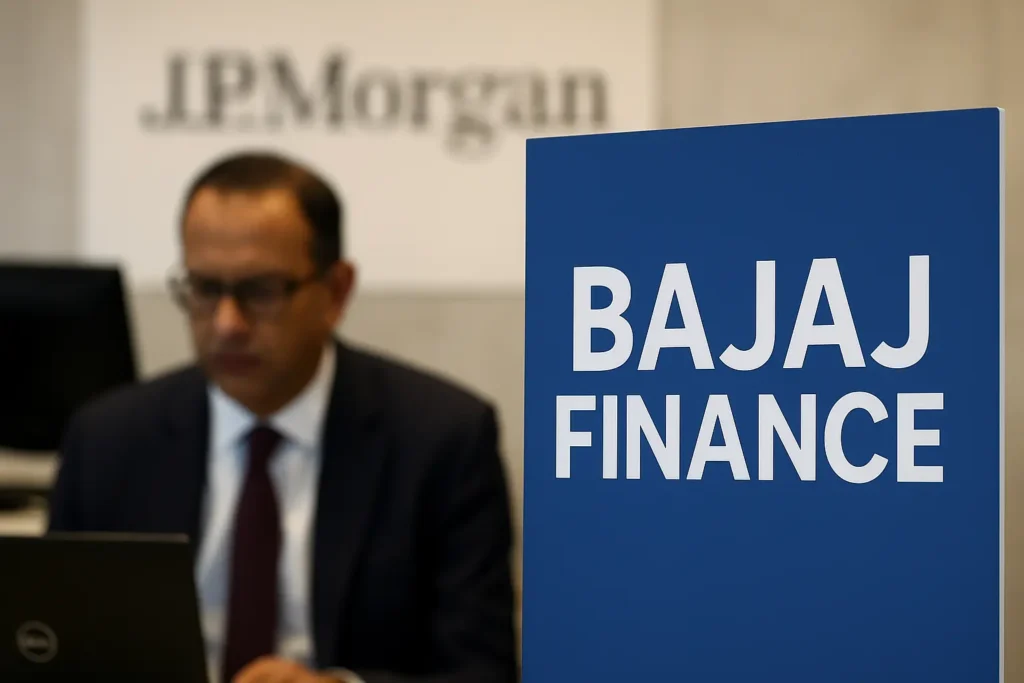Bajaj Finance stock plunged over 5% after JPMorgan issued a downgrade and analysts flagged upcoming financial stress. Discover what’s behind the fall and why it matters to global investors, including Americans watching India’s financial markets.
🔍 Introduction: Bajaj Finance Takes a Hit
Bajaj Finance, one of India’s largest non-banking financial companies (NBFCs), saw its shares crash by more than 5% after JPMorgan downgraded the stock. The move came with a stern warning about possible financial stress and slower growth ahead. For investors—especially global ones keeping an eye on emerging markets—this downgrade is not just a local ripple, but a signal with broader implications.
But what exactly triggered this sharp sell-off? Is this just market overreaction or a sign of deeper issues?
Let’s unpack the story.
💼 What Did JPMorgan Say?
🛑 The Downgrade: From Neutral to Underweight
JPMorgan analysts downgraded Bajaj Finance from Neutral to Underweight, citing concerns about valuation, competition, and potential margin compression in its lending business. The investment firm also cut its price target significantly, prompting panic selling among retail and institutional investors.
“Valuation is stretched, competition is intensifying, and we see downside risks to earnings estimates in the coming quarters.” — JPMorgan Report
📊 Stock Market Reaction
Immediately following the downgrade:
- Bajaj Finance shares fell 5.3% intraday
- Market capitalization dropped by over $3 billion
- The broader Nifty Financial Services index also showed weakness, led by NBFCs
For a stock that has been a darling of long-term investors, this sharp correction caught many off guard.
⚠️ Why Are Analysts Worried About Bajaj Finance?
1. Rising Competition in Consumer Lending
With the entry of tech-driven fintech startups and traditional banks stepping up their digital game, Bajaj Finance’s once-unquestioned dominance in consumer and personal loans is under pressure.
2. High Valuation Multiples
The stock had been trading at a Price-to-Earnings (P/E) ratio far higher than its peers. While the premium was justified during growth periods, analysts now believe that it’s unsustainable if margins compress.
3. Potential Asset Quality Stress
Analysts from other brokerages including Nomura and Kotak Institutional Equities also issued caution, highlighting:
- Increasing delinquencies in unsecured loan segments
- Slower collection efficiencies compared to last year
- Exposure to high-risk retail borrowers
🧩 A Broader Economic Picture: Why This Matters to American Investors
Bajaj Finance isn’t just a major Indian lender—it’s a bellwether for consumer credit health in one of the world’s fastest-growing economies. American hedge funds and mutual funds with exposure to emerging market ETFs and Indian equities are directly impacted.
Moreover:
- A slowdown in Bajaj Finance may indicate weakening consumer demand
- It may reflect tightening liquidity conditions in India
- It adds to broader investor sentiment around global interest rate cycles
In short, this isn’t just India’s problem.

📉 Historical Context: Is This the First Time?
Not at all. Bajaj Finance has seen volatility before:
- COVID-19 Crash: Stock fell over 40% before bouncing back
- RBI Norm Changes (2021): Triggered a temporary dip due to lending cap tightening
But this time, the issue isn’t regulatory—it’s structural competition and market dynamics, which are harder to fix quickly.
🧠 Expert Opinions & What Comes Next
🧾 Nomura: “Cautious in the near term”
The firm kept a Neutral rating but highlighted concerns over loan book concentration and pressure on Net Interest Margins (NIMs).
🧾 Kotak Institutional: “Time to be selective”
Analysts advised staying away until more clarity emerges in upcoming quarterly results.
🧾 ICICI Securities: “Good company, wrong price”
They maintain that Bajaj Finance remains strong operationally but recommend waiting for better entry levels.
💡 What Should Investors Do Now?
✅ For Indian Retail Investors:
- Avoid panic selling
- Reassess portfolio exposure to NBFCs
- Wait for management commentary in the upcoming earnings call
✅ For American/Global Investors:
- Monitor global ETFs and mutual funds with exposure to Bajaj Finance
- Evaluate risk in the Indian financial sector broadly
- Track how competitors like HDFC and Axis Bank are adjusting strategies
🏁 Conclusion: A Wake-Up Call, Not a Collapse
Bajaj Finance is still one of the most efficiently run financial institutions in India. However, this downgrade and subsequent market reaction serve as a wake-up call for investors banking on consistent double-digit growth. The company must now prove that it can evolve in an increasingly crowded and regulated lending environment.
For Americans watching international markets, the Bajaj Finance episode reminds us: even star performers are vulnerable to macro trends, policy shifts, and growing competition.
Stay alert, stay diversified, and never ignore red flags—even in booming markets.

Also check it
Trump’s FCC Approves Paramount and Skydance Merger Despite Backlash
